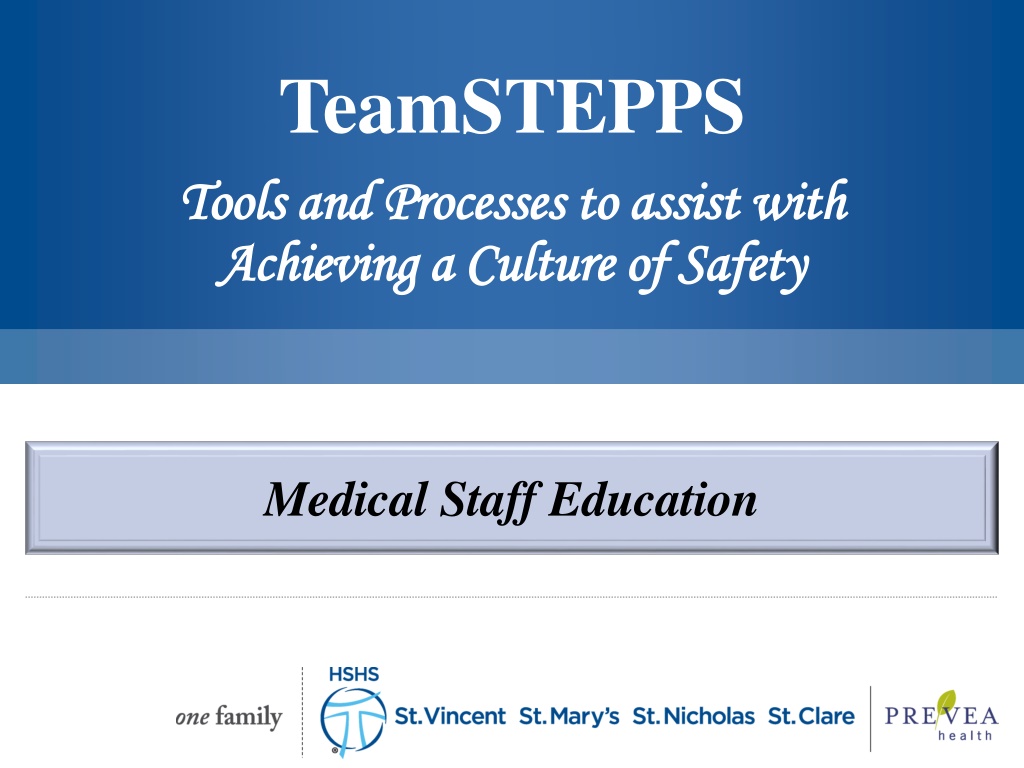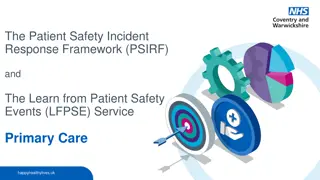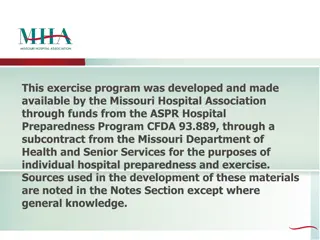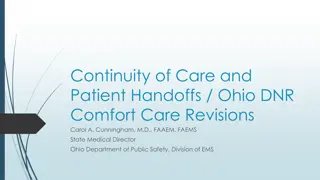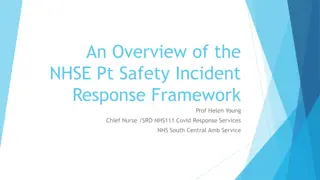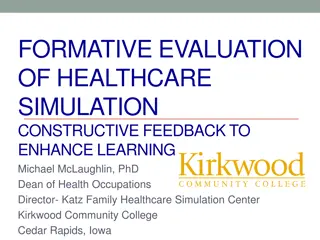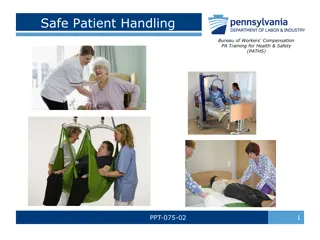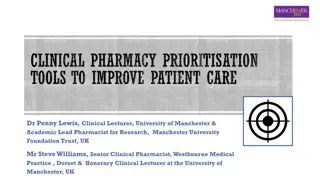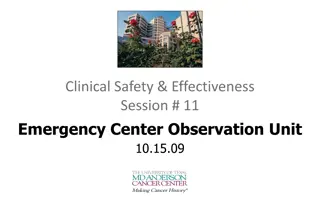Understanding TeamSTEPPS: Tools and Processes for Patient Safety
This article explores the significance of TeamSTEPPS in enhancing patient safety through effective teamwork and communication. It delves into the tools and processes offered by TeamSTEPPS, including CUS, Two-Challenge Rule, and SBAR, emphasizing mutual support and assertive communication for improving healthcare practices. Learn why TeamSTEPPS is important for achieving a culture of safety and discover how it impacts communication in healthcare teams.
Download Presentation

Please find below an Image/Link to download the presentation.
The content on the website is provided AS IS for your information and personal use only. It may not be sold, licensed, or shared on other websites without obtaining consent from the author. Download presentation by click this link. If you encounter any issues during the download, it is possible that the publisher has removed the file from their server.
E N D
Presentation Transcript
TeamSTEPPS Tools and Processes to assist with Tools and Processes to assist with Achieving a Culture of Safety Achieving a Culture of Safety Medical Staff Education
Why Are We Learning About TeamSTEPPS? This System-wide initiative is intended to positively impact patient safety and assist with our Culture of Safety journey through the use of teamwork and communication tools. 2
TeamSTEPPS -- WHAT IS IT? TeamStrategies & Tools to Enhance Performance & Patient Safety TeamSTEPPS is a National program that was developed by the Department of Defense and AHRQ (Agency for Healthcare Research and Quality) This program focuses on reducing patient safety issues by creating effective teamwork and communication through the use of specific strategies and tools 3
Why is TeamSTEPPS Important? TeamSTEPPS improves communications in team work. The Joint Commission data continues to demonstrate the importance of communication in patient safety. 1995 2005: Ineffective communication identified as root cause for nearly 66 percent of all reported sentinel events* 2010 2013: Ineffective communication among top 3 root causes of sentinel events reported** * (JC Root Causes and Percentages for Sentinel Events (All Categories) January 1995 December 2005) ** (JC Sentinel Event Data (Root Causes by Event Type) 2004-2012) 4
What are the TeamSTEPPS Tools we will be using? TeamSTEPPS offers a variety of tools to enhance communication. We will be focusing on the following tools: CUS The Two-Challenge Rule SBAR 5
Mutual Support as a Team - Using C.U.S Using the C.U.S. tool, team members: Assist each other Provide and receive feedback Exert assistance and advocate behaviors when patient safety is threatened 6
What Is C.U.S? CUS CUS is using the following assertive statements: I am C ONCERNED! I am U NCOMFORTABLE! This is a S AFETY ISSUE! By using CUS the colleague will Stop the Line https://www.ahrq.gov/teamstepps/instructor/videos/index.html 7
Scenario One A 63-year-old woman is undergoing cataract surgery. The surgeon calls for the lens, and the circulating nurse, just returning to the block of cases from his lunch, presents what he thinks is the correct lens. Without looking at the lens, the surgeon confirms and asks the nurse to open the container. The nurse states, I am Concerned that I may not have the right lens. I am Uncomfortable with opening it. This is a Safety issue. I need you to look at the box before I open it. The lens turns out to be the lens intended for the next patient of the day. The surgeon promptly thanks the RN for sharing his concerns and the incident is avoided. Tool: CUS 8
Two-Challenge Rule The Two-Challenge Rule is used when an initial assertion is ignored. Such as if you used CUS and your request to stop the line was ignored. It is your responsibility to assertively voice your concern at least two times to ensure that it has been heard. The member of the team being challenged must acknowledge stopping the line? If the outcome is not acceptable: Take a stronger course of action Elevate your concern, which means take the concern to a leader or take up the chain of command. If an unsafe condition, you have the right and responsibility to stop the line ! 9
Two-Challenge Rule continued: The Two-Challenge Rule empowers any team member to stop the line if he or she senses or discovers a safety concern. The Two-Challenge Rule is an action to never to be taken lightly, but it requires immediate challenge to stop the process and to gain resolution of the safety issue. STOP THE LINE! 10
Scenario Two A Surgical Tech was setting up for a new case and noticed that there was bone debris on an instrument that had been sterilized as part of a whole tray of instruments. The Surgical Tech notified the Circulating Nurse and requested to replace the particular instrument from the tray. The Circulating Nurse recognized that the entire tray needed to be replaced because the whole tray potentially had been affected. The Circulating Nurse spoke up and expressed this concern about not replacing the whole tray by using CUS. This was an uncommon situation and there was not consensus on how to proceed. Decision was made to be extra cautious and replace the whole tray. Tool: Two-Challenge Rule 11
When to Use SBAR With physicians when talking about patients Phone conversations and Doc Halo With other nurses and ancillary departments 12
What is SBAR? SBAR is: A framework for team members to effectively communicate information to one another Communicate the following information: Situation What is going on with the patient? Background What is the clinical background or context? Assessment What do I think the problem is? Recommendation & Requests What would I recommend? https://www.ahrq.gov/teamstepps/instructor/videos/index.html 13
Scenario Three A patient was on a balloon pump and the strip readings appeared to have an issue. At this hospital, they do not receive balloon pumps often so there was an education barrier. The RN then called the CVICU at the other hospital who is more familiar with this treatment to explain that she was Concerned and needed more direction. The RN at the other hospital explanation was very helpful and explained details to the RN. This RN also contacted the attending physician regarding her concerns for the patient's urine output, she explained the situation using an SBAR method and received good feedback and orders. Tool: SBAR S - I am calling about patient Jane Doe in ICU room 8. She has only put out 50 ml of urine in the last 4 hours. Her last blood pressure was 150/89 and her heart rate is trending in the 90s. She has IV fluid running 0.9 NS at 125 ml/hour. She has crackles in the bilateral bases of her lungs. B - She came in with chest pain, had a heart catheterization yesterday, and has been on a balloon pump since. She also has a history significant for CHF. A - She has already received 20 mg of Lasix IV this morning. R- Would you like me to get some lab work and a chest xray and call you with the results? 14
